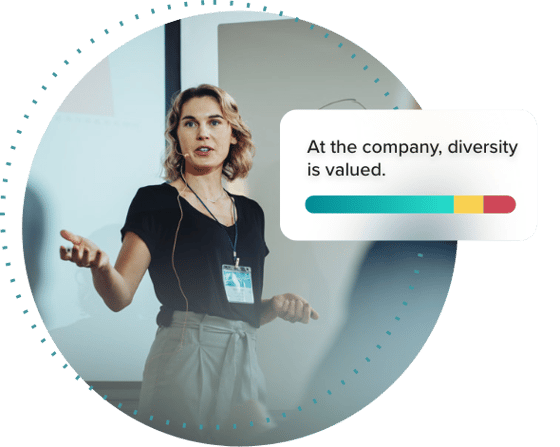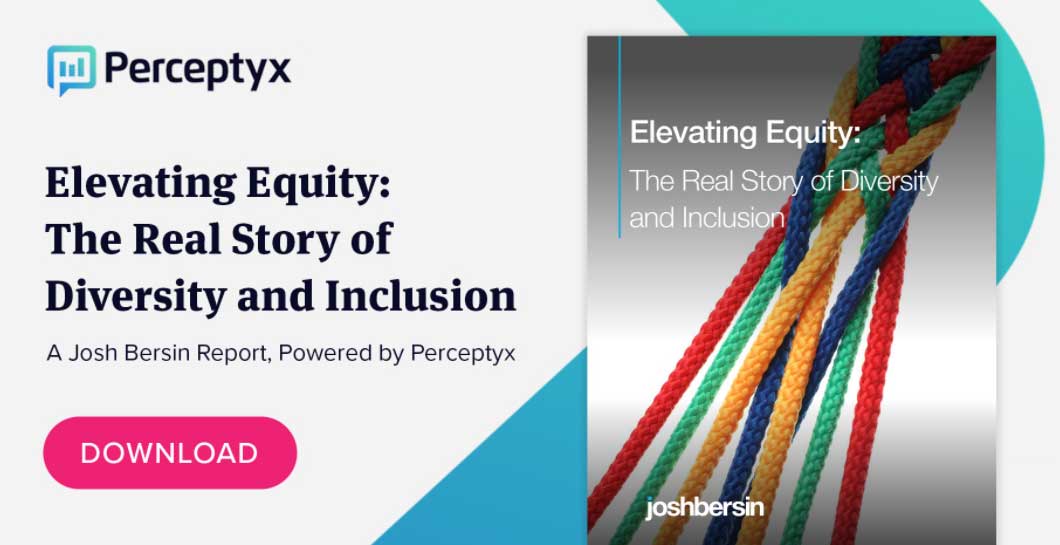Diversity, Equity, Inclusion & Belonging
Improving the Employee Experience for All
The data is clear: investing in DEIB is just good business. It drives greater levels of innovation, customer service, and long-term growth. But how can your company move from intention to action? It starts with listening.
“Why is listening so important? Because it switches DE&I from a compliance program to one focused on performance and growth.”
Looking at Your Employee Experience Through a DE&I Lens
DEIB Is Not Simply an HR Problem
The most impactful and successful DEIB initiatives originate from and are powered by business strategy, not HR programs. While DEIB training, resource groups, hiring practices, and other similar efforts do add value, to drive substantive change, DEIB must be seen and implemented as a top-down, pervasive strategy.

Bring DEIB Challenges & Opportunities Into Focus
The People Insights Model can help you understand what your organization is doing well when it comes to DEIB, where improvements are needed, and how individual employees view DEIB progress and its importance within your culture.

Let Listening Drive Action
Develop an action plan to create a more inclusive work experience by using the data gathered from employee surveys. Perceptyx helps analyze your data, identify strengths and weaknesses, and determine the best areas of focus. For employee listening programs to be successful, leaders must engage employees, share results quickly, and act on that feedback. This ensures employees are engaged, have an inclusive experience, and support your action plans.

Driving DEIB Change with Activate
Transform your DEIB strategy with AI-Assisted Action Planning and Intelligent Nudges tailored for diversity, equity, inclusion, and belonging initiatives. Our AI tools strategically convert DEIB insights into precise actions and foster an inclusive culture. AI-Assisted Action Planning meticulously crafts plans to address DEIB challenges, promoting a systemic approach to inclusion. Intelligent Nudges encourage consistent, behavior-focused adjustments, seamlessly promoting diversity and inclusivity daily. Together, these tools proactively drive and sustain significant DEIB progress within your organization.

The 4 Pillars to Measuring DEIB in the Workforce
Belonging
Employees feel connected to, accepted, and valued by their colleagues and leaders.
Authenticity
Employees and leaders are thoughtful and open in relationships, and create a safe and inclusive workplace.
Opportunity
All employees have access to the same opportunities and all employee contributions are measured in the same way, without regard to background and/or individual differences.
Fairness
Employees believe their backgrounds and/or individual differences do not influence how they are treated by their manager.
-
“Our ManpowerGroup Annual People Survey runs smoothly every year because people are very committed to it and they really care a lot about it. We get insight into management, leadership, vision, values, ethics, DE&I — it’s all gathered in MAPS and helps us improve overall employee engagement.”
-
“For Carhartt, putting diversity and inclusion into practice involves building deep connections with each individual associate, celebrating their differences, and encouraging them to bring fresh ideas to the table.”
-
“One of the things we’ve done is to pull out specific metrics so our leaders can monitor DE&I and resiliency on a regular basis. Without the Perceptyx tool, we wouldn’t have that level of access to the DE&I metrics and the trust index.”
Understanding Our Approach to Diversity, Equity,
Inclusion & Belonging
What is DEIB?
DEIB stands for diversity, equity, inclusion, and belonging. While the definition of the terms may be simple, understanding the ideals and creating a workplace focused on them can be quite complex.
Diversity means having a multitude of different cultures, races, perspectives, ages, genders, etc., represented in a particular setting or location, like a company. Equity refers to the assurance that all people are treated impartially, and provided equal possible outcomes, such as career advancement. Inclusion is involving everyone or ensuring that people feel a sense of belonging in a particular group or setting, such as an invitation to provide input during a meeting.
Belonging, a relatively new concept in the DEIB industry, refers to a feeling of security and support when there is a sense of acceptance, inclusion, and identity for a member of a certain group.
It all sounds great, but what does that really mean when it comes to the workplace? Generally, when organizations refer to DEIB, they are speaking about their efforts to create a welcoming environment that treats everyone with respect, provides equal job opportunities, and deliberately seeks the ideas and expertise of diverse employees.
In recent years, DEIB has become a hot-button issue in the workplace, and many companies are refocusing their cultures and values to demonstrate their commitment to this. However, many organizations still struggle with how they define DEIB, so there is much room for improvement when it comes to expanding diversity, equity, and inclusion programs.
At Perceptyx, we believe DEIB is multifaceted. It certainly refers to factual workforce demographics, such as age, race or ethnicity, gender, and sexual identity. But there is also the side that deals with culture, which is more fluid. It's important for leaders to build cultures that consider organizational effectiveness as well as the employee experience.
However, in order to achieve this goal, organizations need to understand how actions can enhance or hinder inclusion, as well as how the feelings of current and new employees impact the culture.
Why Is DEIB in the Workplace Important?
The pandemic has created a unique opportunity for organizations to reimagine and redesign the future of work, including their DEIB practices. While the past year-plus has spotlighted many of the inequities that existed before COVID – especially for women, people of color, and working parents and caregivers – it has also had an equalizing effect: we all bear the same fears for our health and safety, regardless of our race or gender, and we’ve now had the opportunity to see our co-workers daily lives in a new, more empathetic way, even if only through a Zoom window.
A number of surveys have also revealed that as a large number of our workplaces become increasingly remote, many employees are yearning for a sense of connection, a goal that becomes more complicated as more of us are located virtually versus in a physical office.
The first step is recognizing the unique qualities of your employees and then inspiring them to harness these attributes to become the best version of themselves. When people feel like they belong and can bring their whole selves to work, they can flourish. But robust DEIB programs don’t just provide social and emotional benefits, they benefit the bottom-line too.
Retention improves as DEIB programs mature. Employees who feel they belong, and who feel respected, accepted, and valued are more likely to be highly engaged, and therefore, more likely to stay with the organization. Research conducted by the Josh Bersin Academy in partnership with Perceptyx found that organizations who are “excellent” in DEIB are 2.6 times more likely to engage and retain the workforce.
Innovation is also aided by diverse mindsets. People with a wider spectrum of perspectives offer a wider range of ideas. They generate new ways of thinking and can offer new processes and solutions to problems. An enthusiastic flow of ideas also creates the ideal environment for collaboration. However, this diversity needs to be encouraged from the top: the same Bersin Academy research found that organizations whose leaders believe diversity is good for business are 2.9 times more likely to excel at innovation.
Financial performance is similarly correlated with more diverse companies. EVERFI, an educational provider offering DEIB training, found that companies with the most racially diverse workforces have revenue 15 times higher than the least racially diverse companies. A report from Harvard Business Review confirms similar findings have been replicated numerous times over the past 20 years.
Read more about the 5 Key Benefits of DEIB in the Workplace.
Learn more about Why Is DEIB in the Workplace Important?How are DEIB Programs Measured?
Before determining a measurement strategy, companies must understand what DEIB means to them, why it's worth pursuing, and what specific goals and outcomes they want to achieve. Organizations that choose to focus on DEIB may do so because they want to attract and build a more diverse workforce, accelerate or reward more inclusive behaviors, or improve engagement among employees from varied backgrounds. These are all things that can easily be measured by listening to your workforce through a variety of employee surveys.
At Perceptyx, our customers are able to apply listening programs to assess the current state of DEIB factors in their workforce, understand potential gaps and risks that require attention, and then assess whether the resulting programs initiated to address these gaps are having the desired effects.
-
DEIB surveys are valuable for understanding your employees’ current experience, and what they feel could be improved. Perceptyx customers benefit from a deep library of benchmarked questions to uncover key DEIB perceptions and behaviors, and spotlight areas that may need more investigation.
-
Onboarding or new hire surveys provide insights into the factors that make your company attractive to talented candidates from under-represented groups, how the organization is perceived by these newcomers, and what DEIB practices are believed to be most important to their growth and development.
-
Pulse surveys allow for timely feedback when planning and launching new DEIB initiatives, building consensus around impactful actions, or understanding changing employee perceptions in response to specific events.
-
Multi-rater 360 or 180 surveys allow managers to hear from direct reports, peers, superiors, and/or customers about their performance relative to DEIB goals and benchmarks, and what they can do to improve.
At Perceptyx, we use four pillars as critical guideposts to measure diversity, equity, and inclusion in the workforce. As companies look to address issues of DEIB, we believe data from the following four areas will direct the actions that need to be taken by managers and leaders.
Belonging: Do employees feel connected to, accepted by, and valued by their colleagues and managers in the workplace?
Authenticity: Are employees and managers thoughtful, honest, and open in their communication? Do they work collaboratively to create a safe and inclusive workplace?
Opportunity: Do employees believe that their performance evaluation supports positive career momentum? Do employees perceive that they have equal access to opportunities and that their contributions are measured consistently?
Fairness: Do employees believe their backgrounds and/or individual differences do not influence how they are treated by their manager?
Find out more about measuring DEIB in this on-demand webinar.
Learn more about How are DEIB Programs Measured?How Can a Company Improve DEIB Metrics and Practices?
Every company, every leader, every employee is different. As a result, there is no one-size-fits-all strategy for measuring or improving DEIB. But while your approach to building a DEIB program is likely to be unique, there are common, best practice steps you can take to ensure you achieve your goals.
It starts with knowing your specific DEIB objectives and outcomes, listening to your employees via the right channels to capture key data points about the current state of DEIB in your company, analyzing the results, and developing the right plan of action.
It’s also important to remember that, as with any substantive corporate change initiative, C-level commitment is critical. When executives lead by example, it trickles down throughout the organization. Research from Josh Bersin further reinforces this, finding that, “senior leadership commitment is a prerequisite of DE&I success, and it is a factor that has a bigger impact on outcomes than practices around training or recruitment.”
At Perceptyx, we understand that DEIB is an ongoing process. As the world and workforce demographics change, so must your approach to DEIB. It will require continuous listening, and confronting unconscious biases at an organizational and employee level.
Survey data can pinpoint areas of friction and barriers to collaboration, as well as what is working well. Surveys are also useful in monitoring the effectiveness of DEIB programs, and what your company is doing to advance them.
With our diverse survey portfolio, an advanced people analytics and insights platform, and nearly 20 years of expertise understanding and assessing employee experience, Perceptyx is uniquely qualified to help you identify what you should be asking employees to design and build a more inclusive organization.
What Should a Company Look for When Selecting a DEIB Survey Partner?
Flexibility in technology and methodology is increasingly important when it comes to selecting a vendor partner. While up-to-date and advanced technology is vital, organizations need to be able to customize their surveys, and know that a survey provider is willing to work with them to execute the right solution. It should be a true partnership, with demonstrated understanding of your goals and how you work. Additionally, you will want a partner experienced in the legal nuances of DEIB to guide you through asking appropriate, law-abiding questions.
At Perceptyx, we partner with large, complex organizations – including more than 30% of the Fortune 100. We understand that each is unique, and needs an employee listening program designed specifically for them. Because we work with diverse organizations with employees stretched across the globe, we also understand the importance of providing surveys in a multitude of languages with translation options to analyze thousands of open-ended comments.
It is also critical to have the ability to integrate employee demographic and business performance data into one dashboard. This way connections between the employee experience and performance outcomes can be identified and linked across multiple surveys. Tailoring the entire experience and adapting questions to the specifics of culture, region, and location, while providing real-time results, is also exceptionally important.
On-Demand Webinar: A 10-Point Framework For Excellence in DEIB
Watch nowResources
Discover the Latest DEIB Trends, Data & Best Practices
Elevating Equity: The Real Story of Diversity and Inclusion
In this study from Josh Bersin and team, uncover which DE&I practices matter most when it comes to delivering positive business outcomes.
Download Elevating Equity: The Real Story of Diversity and InclusionThe People Analytics Playbook
Learn the right questions to ask to understand how your employees feel about diversity and inclusion in the workplace.
Download The People Analytics Playbook6 Top Trends in Workplace DEIB for 2024
In this article, we dive into the top trends in DEIB and explore the complexities and evolving nature of DEIB initiatives amid political and legislative pressures.
Read more about 6 Top Trends in Workplace DEIB for 2024Getting started is easy
Advance from data to insights to focused action


